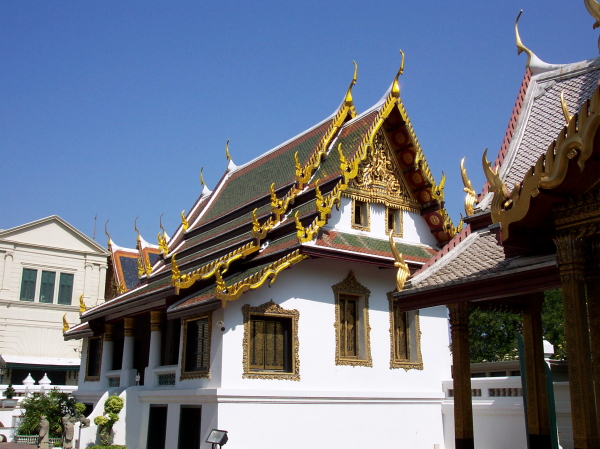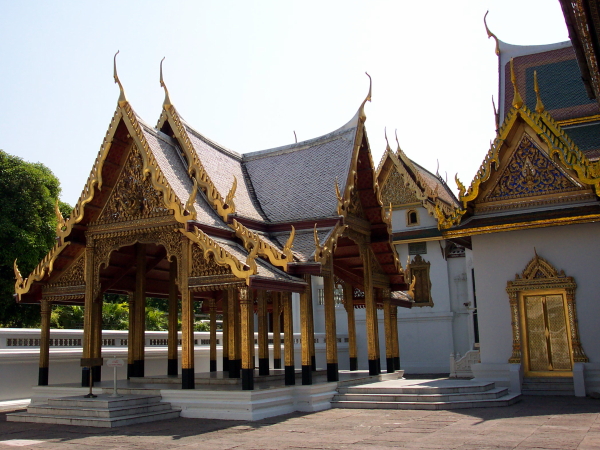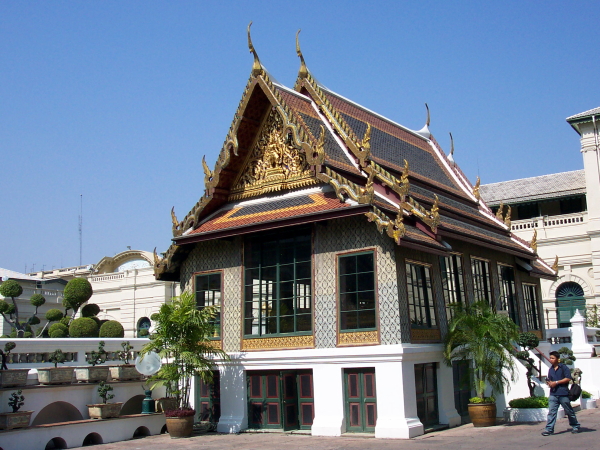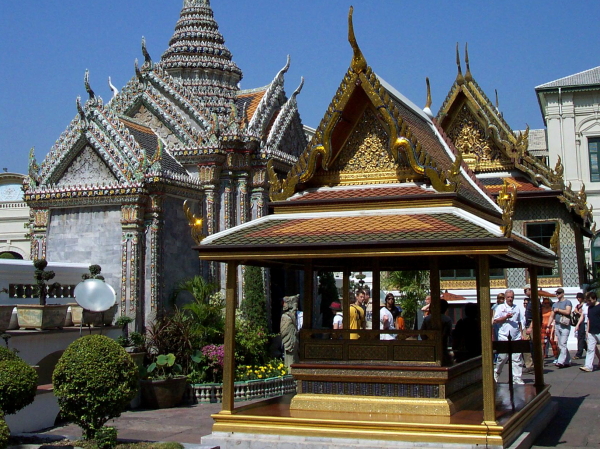The group of buildings near the eastern edge of the central court were built to be the main residence and audience hall for the king. The main building of the group, barely visible to tourists, is the Chakraphat Phiman hall. It was the primary residence of the first three kings of the Chakri dynasty, and it is still customary for new kings to spend at least one night here after their coronation.
In front of the Chakraphat Phiman hall is the cross shaped Phaisan Thaksin hall. This was the place where the king dined, relaxed and held informal audiences. King Rama II held his coronation here, and it has become the tradition for new kings to receive the invitation to take the throne in this hall. In the middle of this hall is the Phra Siam Devadhiraj, the symbolic guardian of the country. It was installed by King Rama IV.
In front and most visible is the Amarin Winichai Mahaisun Audience hall. This is the most important hall in the group, since it is where formal audiences are held, as well as every important state occasion conducted. There are actually two thrones in the hall, both gilded. The original tall boat-like Busabok Mala Maha Chakraphat Phiman throne is now used as an alter. Kings now use the lower Phuttan Kanchanasinghat throne.
 The Sastraphom Hall where Mon monks blessed the waters
The Sastraphom Hall where Mon monks blessed the watersThe Amarin Winichai Mahaisun Audience hall is open to the public on weekdays only. On your left in the walled enclosure as you enter the hall is the Ho Sastraphom, a small pavilion where Mon monks blessed the waters that would be sprinkled over the Phra Maha Monthien. In times of war, the lustral water was also used to bless weapons and charms for the soldiers.
 The Ratcharuedee Pavilion for bathing rites
The Ratcharuedee Pavilion for bathing rites
Next to the Ho Sastraphom is a beautiful open pavilion called the Ratcharuedee Pavilion. It was used for the king's purification bath during his birthday rites as well as other ceremonial occasions.
Beyond the Ratcharuedee Pavilion you can see a curiously somewhat Chinese porch leading up to the gallery of the central hall. However, the false windows on either side of the entry are more Western in style.
 The Dusidaphirom Pavilion from inside the palace walls
The Dusidaphirom Pavilion from inside the palace wallsAt the northwest corner of the group is the Dusidaphirom Pavilion. It was originally an open sala, but was enclosed by Rama III. It was used as a place for relaxation as well as a dressing chamber for the king when departing by palanquin or elephant. You can see the platform for mounting an elephant on the west side, with poles for tying the elephant.
 The Sanam Chan Pavilion, where the king would rest when overseeing construction
The Sanam Chan Pavilion, where the king would rest when overseeing constructionYou can take it with you.
Wish you could have this information with you when you visit the Grand Palace? Now you can. Check out our Bangkok Essentials ebook.
Near the Dusidaphirom Pavilion is a small covered 'bed' called the Sanam Chan Pavilion. The pavilion was used by King Rama II as a place for relaxation and to oversee construction projects within the palace. Its small size allowed it to be easily moved to a building site. Although small, the pavilion is one of the best examples of Thai architecture that exists from the period. The gable end is decorated with a delicately carved wooden vine motif set against mirrored glass. The base is decorated with black lacquer and glass in a technique similar to mother-of-pearl inlay.
Next: The Chakri Maha Prasat »